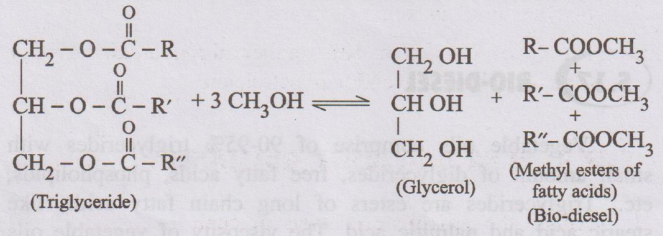Engineering Chemistry: Unit IV: a. Fuels
Bio-Diesel
Definition, Manufacture, Properties, Structural Diagram, Advantages and Disadvantages
The viscosity of vegetable oils are higher and their molecular weights are in the range of 600 to 900, which are about 3 times higher than those of the diesel fuels.
BIO-DIESEL
Vegetable oils comprise of 90-95% triglycerides with small amount
of diglycerides, free fatty acids, phospholipids, etc., Triglycerides are
esters of long chain fatty acids, like stearic acid and palmitic acid. The
viscosity of vegetable oils are higher and their molecular weights are in the
range of 600 to 900, which are about 3 times higher than those of the diesel
fuels.
Problems in using vegetable oils directly
1. As the viscosity of vegetable oils are high, atomization is
very poor and hence inefficient mixing of oil with air leads to incomplete
combustion.
2. Oxidation and thermal polymerization of vegetable oils cause
deposit formation.
3. Their high viscosity causes misfire and ignition delay.
4. Their high volatility and consequent high flash point lead to
more deposit formation.
5. The use of vegetable oils as direct fuel requires modification
of the conventional diesel engine design.
Manufacture : Trans-esterification (or) alcoholysis
The above problems are overcome by reducing the viscosity of the
vegetable oils by the process known as trans-esterification or alcoholysis.
Alcoholysis is nothing but displacement of alcohol from an ester by another
alcohol.
It involves treatment of vegetable oil (sunflower oil, palm oil,
soyabean oil, mustard oil, etc) with excess of methanol in presence of catalyst
to give mono ethyl esters of long chain fatty acid and glycerine. It is allowed
to stand for some time and glycerine is separated.
Alcoholysis reaction is represented as

Methyl esters of fatty acids, thus formed, are called
“Bio-diesel”. Bio-diesel is defined as mono-alkyl esters of long chain fatty acids
derived from vegetable oils or fats. It is a pure fuel before blending with
conventional diesel fuel. Bio-diesel can be blended with petroleum diesel.
1. Advantages and Disadvantages of Bio-diesel
Advantages
1. Bio-diesel is bio-degradable.
2. It is prepared from renewable resources.
3. The gaseous pollutants are lesser as compared to the conventional
diesel fuel.
4. Bio-diesel can be produced from different types of vegetable
oils.
5. Best engine performance and less smoke emission are achieved.
Disadvantages
1. Bio-diesel gels in cold weather.
2. As bio-materials are hygroscopic, bio-diesel can absorb the
water from atmosphere.
3. Bio-diesel decreases the horse power of the engine.
4. Bio-diesel degrades and soften the rubber and plastics, that
are used in some old cars.
5. Bio-diesel has about 10% higher nitrogen-oxide (NOx)
emission than conventional petroleum.
Engineering Chemistry: Unit IV: a. Fuels : Tag: Engineering Chemistry : Definition, Manufacture, Properties, Structural Diagram, Advantages and Disadvantages - Bio-Diesel
Related Topics
Related Subjects
Engineering Chemistry
CY3151 1st Semester | 2021 Regulation | 1st Semester Common to all Dept 2021 Regulation
